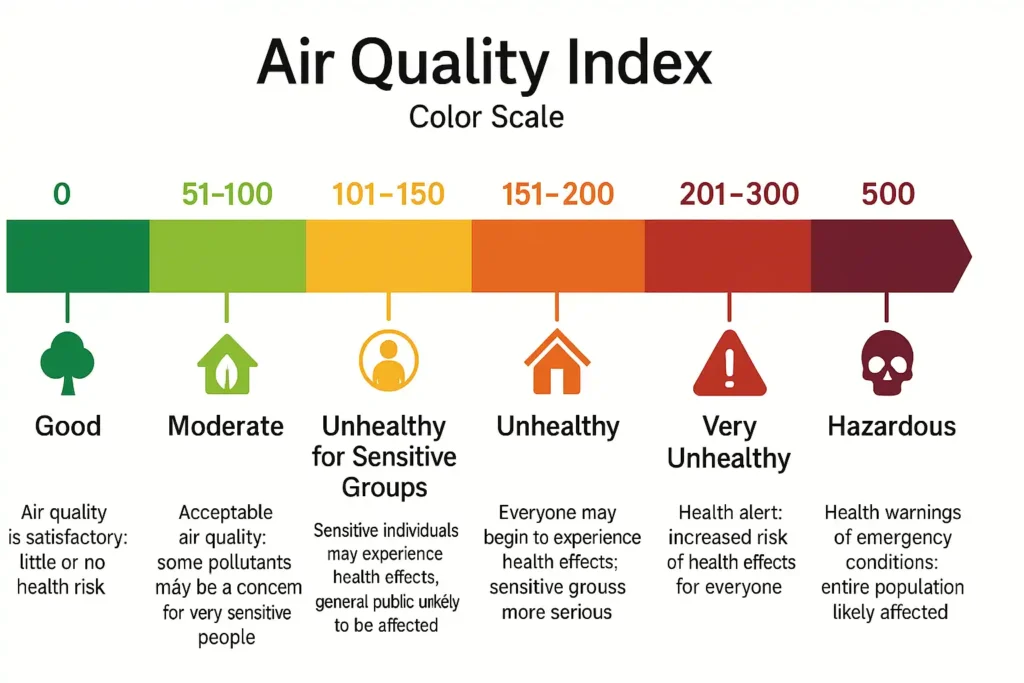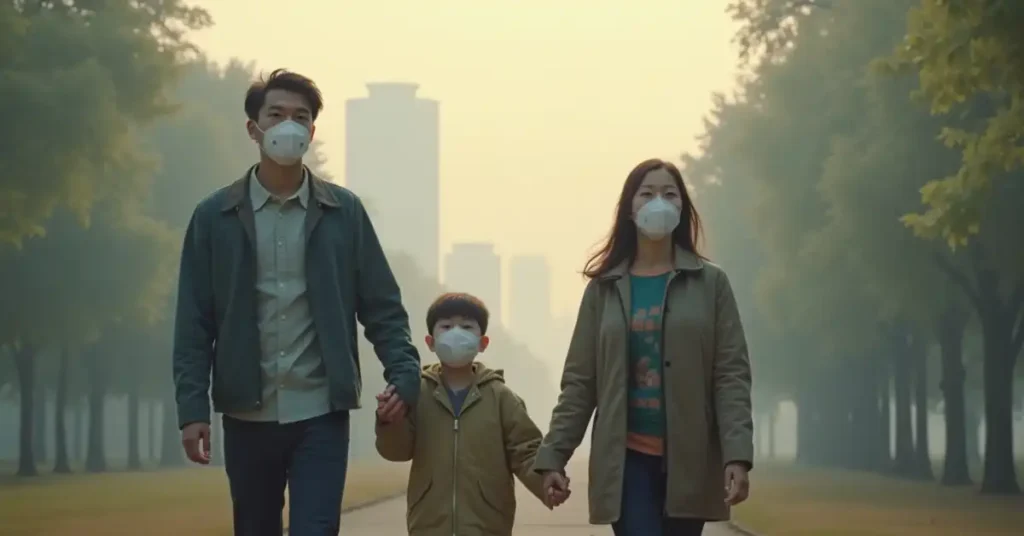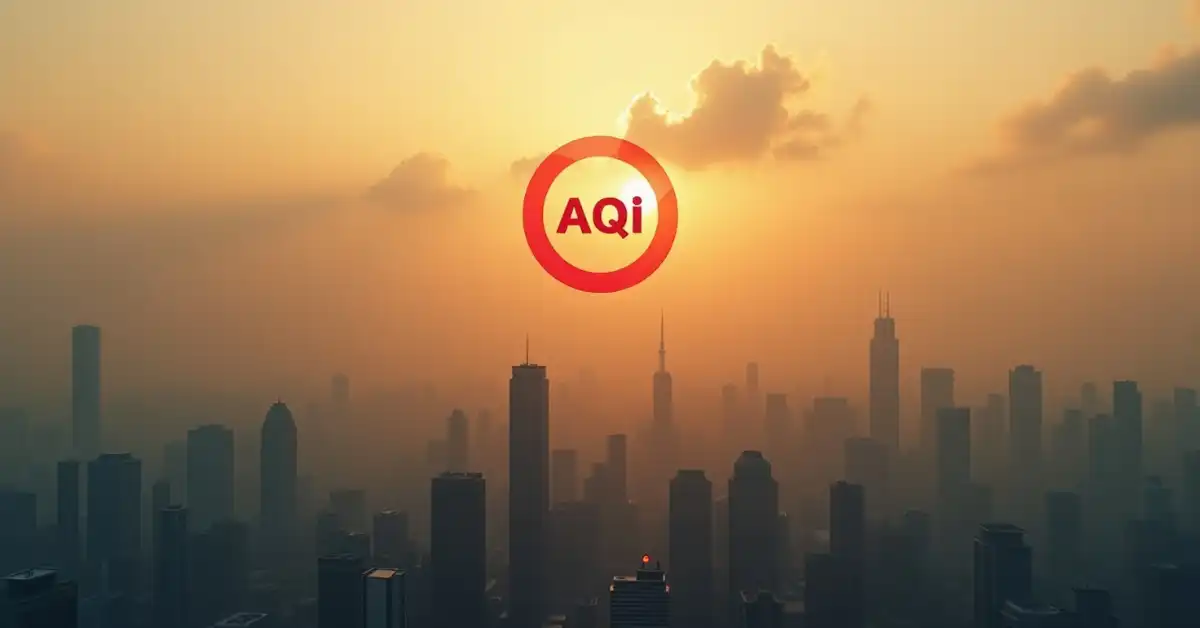Heard about an “Air Quality Alert” and wondering what it means for you? Simply put, an air quality alert is an official heads-up that the air outside might be unhealthy to breathe right now, or is expected to be soon. These alerts are sent out by experts at places like the Environmental Protection Agency (EPA) and your local or state environmental agencies to help protect your health, especially if you’re in a sensitive group. Think of it as a health forecast for the air.
What Exactly Is an Air Quality Alert?
An air quality alert is a notification issued when the concentration of pollutants in the air reaches levels that could be harmful to people’s health. The main goal is simple: to protect public health. These alerts warn people, especially those who might be more vulnerable (like kids, older adults, or people with lung or heart conditions), that the air isn’t great and give advice on how to reduce exposure.
These aren’t just random warnings. They come from official sources like the U.S. Environmental Protection Agency (EPA), state environmental protection agencies (like the Texas Commission on Environmental Quality or TCEQ), and local air quality districts. They use scientific monitoring and forecasting to decide when an alert is needed.
Why are these alerts becoming more common? Things like weather patterns, traffic, industrial activity, and sadly, increasing wildfires can all lead to poor air quality. In 2023, major U.S. cities saw hundreds of days with air quality alerts, partly driven by smoke from wildfires. This shows why understanding these alerts is more important than ever. This guide will walk you through how alerts work, what they mean for your health, and the simple steps you can take to stay safer.
Understanding the Air Quality Index (AQI)
The main tool used for these alerts is the Air Quality Index, or AQI. Think of the AQI as a “thermometer” for air quality that runs from 0 to 500. Lower numbers mean cleaner air, while higher numbers mean more pollution and greater health concern. The EPA developed the AQI to make it easy to understand daily air quality and its potential health effects.
The AQI uses a color-coded system with six categories:

- Green (AQI 0-50): Good – Air quality is great! Pollution poses little or no risk. It’s a good day to be active outside.
- Yellow (AQI 51-100): Moderate – Air quality is acceptable. However, there might be a slight risk for a very small number of people who are unusually sensitive to air pollution. Most people are fine.
- Orange (AQI 101-150): Unhealthy for Sensitive Groups – This is where alerts often start. People with lung disease (like asthma), heart disease, older adults, children, and people active outdoors may experience health effects. The general public is less likely to be affected. Sensitive groups should reduce prolonged or heavy exertion outdoors.
- Red (AQI 151-200): Unhealthy – Now, everyone might start to feel some health effects. Members of sensitive groups could experience more serious issues. It’s advised that sensitive groups avoid prolonged outdoor exertion, and everyone else should reduce it.
- Purple (AQI 201-300): Very Unhealthy – This triggers a health alert. The risk of health effects increases for everyone. Sensitive groups should avoid all outdoor physical activity. Everyone else should avoid prolonged or heavy exertion outdoors.
- Maroon (AQI 301+): Hazardous – This is a health warning of emergency conditions. The entire population is likely to be affected. Everyone should avoid all outdoor exertion.
The AQI value is usually determined by the pollutant with the highest concentration at that time. An AQI of 100 generally corresponds to the national air quality standard set by the EPA to protect public health.
Major Pollutants Measured in Air Quality Alerts
The AQI tracks several key air pollutants regulated by the Clean Air Act. The most common ones triggering alerts are:
- Ground-level Ozone (O₃): This isn’t the helpful ozone high up in the atmosphere. Ground-level ozone is “bad” ozone, created when pollutants from cars, power plants, and industrial facilities react with sunlight. It’s often worse on hot, sunny days. Breathing ozone can irritate your lungs, reduce lung function, and worsen conditions like asthma, bronchitis, and emphysema.
- Particulate Matter (PM₂.₅ and PM₁₀): This is a mix of tiny solid and liquid particles suspended in the air. Think dust, soot, smoke, and smog. PM₂.₅ refers to fine particles (2.5 micrometers or smaller – way too small to see), and PM₁₀ includes slightly larger particles. Sources include wildfires, construction sites, power plants, and vehicle emissions. These tiny particles can get deep into your lungs and even your bloodstream, causing respiratory problems, heart attacks, and other serious issues. Wildfire smoke is a major source of PM₂.₅ that has caused widespread alerts recently.
- Carbon Monoxide (CO): An odorless, colorless gas formed when fuel doesn’t burn completely. Cars are a major source. CO reduces the oxygen getting to your organs.
- Sulfur Dioxide (SO₂): Comes mainly from burning fossil fuels at power plants and industrial facilities. It can irritate airways and make breathing difficult, especially for people with asthma.
- Nitrogen Dioxide (NO₂): Primarily from vehicle exhaust and power plants. It can irritate lungs and lower resistance to respiratory infections.
Advanced monitoring networks on the ground and even satellites help measure these pollutants to determine the AQI.
Health Implications of Poor Air Quality
Breathing polluted air isn’t just unpleasant; it can seriously affect your health, both right away and over time.
Short-Term Effects (Hours or Days):
- Irritated eyes, nose, and throat
- Coughing, wheezing, and shortness of breath
- Headaches, dizziness, nausea
- Asthma attacks
- Worsening of existing lung conditions (like COPD) or heart conditions
- Increased risk of respiratory infections like pneumonia and bronchitis
Long-Term Health Risks (Years of Exposure):
- Chronic bronchitis
- Reduced lung growth and function, especially in children
- Increased risk of heart attacks, strokes, and cardiovascular disease
- Higher risk of developing lung cancer
- Emerging research links air pollution to problems like dementia and cognitive decline.
Poor air quality takes a real toll. Studies show increases in hospital admissions and emergency room visits for respiratory and cardiovascular problems during high pollution days. Researchers estimate that fine particle pollution (PM₂.₅) contributes to tens of thousands of premature deaths in the U.S. each year. Globally, the World Health Organization estimates that combined outdoor and household air pollution causes about 7 million premature deaths annually.
Who Needs to Be Extra Careful? (Vulnerable Populations)
While unhealthy air can affect anyone, some groups are more sensitive and need to pay closer attention to air quality alerts:
- Children: Their lungs are still developing, they breathe more air per pound of body weight than adults, and they often spend more time playing outdoors.
- Older Adults: Their bodies may not cope as well with air pollution, and they are more likely to have existing heart or lung conditions.
- People with Pre-existing Conditions:
- Respiratory diseases: Asthma, COPD (Chronic Obstructive Pulmonary Disease), emphysema, chronic bronchitis. Poor air quality can trigger attacks and worsen symptoms.
- Cardiovascular diseases: Heart failure, coronary artery disease, high blood pressure. Air pollution can strain the heart.
- Diabetes: Some studies suggest people with diabetes may be at higher risk.
- Outdoor Workers and Athletes: People who work or exercise vigorously outdoors breathe in more air and potentially more pollutants.
- Pregnant Women: Exposure to air pollution may pose risks to both the mother’s health and the developing baby.
- People in Environmental Justice Communities: Often, low-income communities and communities of color face higher exposure to pollution due to the location of highways, industrial facilities, and other sources.
If you or someone you care for falls into one of these groups, it’s especially important to know the daily air quality and take action when alerts are issued.
How to Access and Interpret Air Quality Alerts
Staying informed is key to protecting yourself. Luckily, there are many easy ways to check the air quality:
- Official Websites:
- AirNow.gov: This is the EPA’s main hub for real-time and forecast AQI data across the U.S. You can enter your zip code for local conditions. It also includes fire and smoke maps.
- State Environmental Agencies: Most states have websites with local air quality data and alert information (e.g., Florida DEP, Oregon DEQ, TCEQ in Texas).
- Local Air Quality Districts: Some regions have their own agencies (like LRAPA in Eugene, OR).
- Digital Tools:
- Mobile Apps: Many weather apps now include AQI information. Dedicated apps like the AirNow app, IQAir AirVisual, and others provide detailed data and alerts.
- Email/Text Alerts: Services like EPA’s EnviroFlash allow you to sign up for email or text alerts when air quality is expected to be poor in your area.
- Social Media: Many agencies post alerts on platforms like Twitter or Facebook.
- News and Weather Reports: Local news stations often include the AQI forecast in their weather segments, especially when an alert is active.
Interpreting the Information:
- Current vs. Forecast: Pay attention to whether the report is for current conditions or a forecast for later today or tomorrow. Forecasts help you plan ahead.
- Main Pollutant: Sometimes the alert will specify the main pollutant causing the issue (e.g., “Ozone Action Day”). This can be helpful, especially if you know you’re sensitive to a particular pollutant.
- Recommended Actions: Alerts usually come with advice based on the AQI color code, like suggesting sensitive groups limit outdoor activity.
What to Do During an Air Quality Alert
When the AQI climbs into unhealthy ranges (Orange, Red, Purple, Maroon), taking simple steps can make a big difference:
- Reduce Time Outdoors: Especially limit strenuous activities like running, heavy yard work, or sports. The harder you breathe, the more pollution you inhale.
- Stay Indoors: Keep windows and doors closed. If you have air conditioning, run it. Set the AC to recirculate air so it doesn’t pull in polluted outdoor air. Make sure your AC filter is clean.
- Use Air Cleaners: Portable air cleaners with HEPA filters can help reduce indoor particle levels, especially in a “clean room” like a bedroom.
- Avoid Adding Indoor Pollution: Don’t fry foods, burn candles or incense, or vacuum (unless you have a HEPA filter vacuum), as these activities can worsen indoor air.
- Wear a Mask (If Appropriate): For particle pollution (like smoke), a well-fitting N95 or KN95 respirator mask can offer protection if you must be outdoors. Simple cloth or surgical masks offer very little protection against fine particles. Masks don’t filter out ozone gas.
- Plan Ahead: Reschedule outdoor events or move them indoors if possible during alerts. Schools and organizers of public events should have protocols for poor air quality days.
- Listen to Your Body: If you start experiencing symptoms like coughing, wheezing, or chest tightness, go indoors and reduce your activity level. Contact your doctor if symptoms are severe or don’t improve.
Do These Alerts Actually Work? (Effectiveness)
Yes, air quality alerts do seem to make a difference, though there’s always room for improvement.
- Behavior Change: Studies show that people do react to alerts. Research has found reductions in outdoor activities, like kids spending less time outside on high ozone days (one study noted about 30 minutes less time outdoors for children with asthma on “Code Red” ozone days compared to cleaner days). Some surveys suggest that up to 57% of people with asthma change their outdoor activity levels based on alerts, especially if advised by a doctor. Another study using a mobile app found over 20% of users avoided outdoor exercise or closed windows in response to high pollution notifications.
- Health Outcomes: There is evidence linking alerts to reductions in respiratory-related hospital visits and emergency room trips, suggesting they help prevent acute health problems. The long-term health benefits are harder to measure but likely exist.
- Challenges:
- Awareness and Understanding: Not everyone knows about the AQI or understands what the different levels mean for their health.
- Alert Fatigue: During long periods of poor air quality (like extended wildfire smoke events), people might start paying less attention to alerts.
- Reaching Everyone: Ensuring alerts reach all populations, including those without easy internet access or in different languages, is an ongoing challenge.
Overall, alerts are a valuable tool. When people understand them and take protective actions, they can reduce their exposure and health risks. Health professionals play a key role; people are much more likely to change their behavior if their doctor advises them to pay attention to the AQI.
Beyond Alerts: Reducing Air Pollution

While alerts help us cope with bad air days, the real goal is to have fewer bad air days in the first place. Reducing air pollution requires effort from everyone:
- Individual Actions:
- Drive less: Use public transit, carpool, bike, or walk when possible. Consider electric vehicles.
- Conserve energy: Use less electricity at home and work. Choose renewable energy options if available.
- Maintain vehicles: Keep cars well-tuned and tires properly inflated.
- Avoid burning: Don’t burn trash or leaves. Use gas or electric lawn equipment instead of gasoline-powered ones.
- Community Efforts:
- Support better urban planning that reduces traffic congestion.
- Advocate for improved public transportation and bike lanes.
- Support local clean energy initiatives.
- Plant trees and support green spaces.
- Policy Solutions:
- Strengthen and enforce emission standards for vehicles and industries (like those under the Clean Air Act).
- Promote renewable energy sources (solar, wind).
- Participate in international agreements to address transboundary pollution and climate change.
Since the Clean Air Act was passed in 1970, the U.S. has made huge progress, reducing emissions of major pollutants significantly even as the economy and population have grown. But challenges remain, especially with climate change impacts like wildfires.
The Future of Air Quality Alerts
Air quality monitoring and alerts are constantly evolving:
- Climate Change Impact: Rising temperatures can worsen ozone formation. Climate change is also linked to more frequent and intense wildfires, leading to more smoke-related air quality alerts. We may see alerts become more common in the future.
- Technology:
- Personal Sensors: Low-cost personal air quality monitors allow individuals to track their immediate environment.
- AI and Better Forecasting: Artificial intelligence is improving the accuracy of air quality forecasts.
- Smart Integration: Alerts might integrate with smart home systems to automatically adjust ventilation or air purification.
- Personalization: Future alerts could potentially be tailored to an individual’s specific health risks and sensitivities.
- Improved Monitoring: Satellite data and expanded ground sensor networks provide a more complete picture of air quality, especially in areas without traditional monitors.
The goal is to make alerts more accurate, timely, accessible, and actionable for everyone.
Conclusion
Air quality alerts are essential tools for protecting our health in a world facing ongoing air pollution challenges. Understanding the Air Quality Index (AQI) and knowing how to respond when alerts are issued can significantly reduce your risk of short-term illness and long-term health problems.
Staying informed is easy with resources like AirNow.gov and mobile apps. Taking simple precautions like reducing outdoor activity and staying indoors during alerts, especially if you’re in a sensitive group, makes a real difference.
While personal actions help protect you on bad air days, tackling air pollution requires broader efforts – from individual choices to community action and strong environmental policies. By working together, we can strive for cleaner air and healthier lives for everyone.
FAQs About Air Quality Alerts
Q1: How are air quality alerts different from weather alerts?
Weather alerts (like thunderstorm or tornado warnings) warn about immediate dangers from meteorological events. Air quality alerts specifically warn about the health risks from breathing polluted air, which might occur even on a sunny day.
Q2: Can I exercise outdoors during an air quality alert?
It depends on the AQI level and your personal health. During Orange alerts, sensitive groups should reduce heavy exertion. During Red alerts, sensitive groups should avoid it, and everyone else should reduce it. During Purple or Maroon alerts, everyone should avoid strenuous outdoor activity. Lighter activity might be okay for healthy individuals in lower alert levels, but listen to your body.
Q3: How can I check air quality when traveling?
Use resources like AirNow.gov or mobile apps – you can usually check by zip code or city name for your destination. AirNow also monitors air quality near U.S. embassies and consulates abroad.
Q4: Are indoor spaces always safe during poor air quality events?
Not necessarily. Outdoor pollutants can seep indoors. Keeping windows closed and running filtered air conditioning or portable air cleaners helps, but indoor air can still be affected, especially during prolonged events or if there are indoor pollution sources.
Q5: What’s the difference between smoke advisories and general air quality alerts?
Smoke advisories are specific alerts issued during wildfire events, focusing on high levels of particulate matter (PM₂.₅) from smoke. General air quality alerts can be triggered by various pollutants, including ozone, PM₂.₅, or others, depending on conditions.
Q6: How accurate are air quality forecasts?
Forecasts are generally reliable, especially for the next day. They use computer models based on weather patterns and emission sources. However, conditions can sometimes change unexpectedly, so it’s good to check current conditions too.

